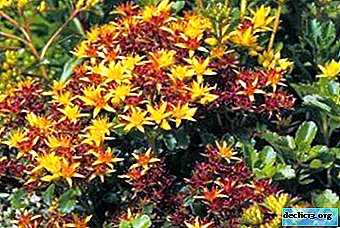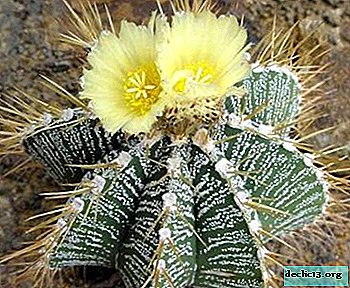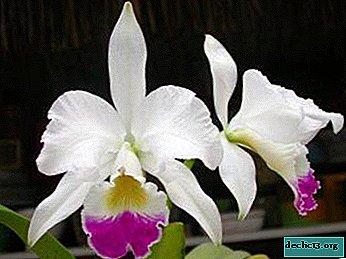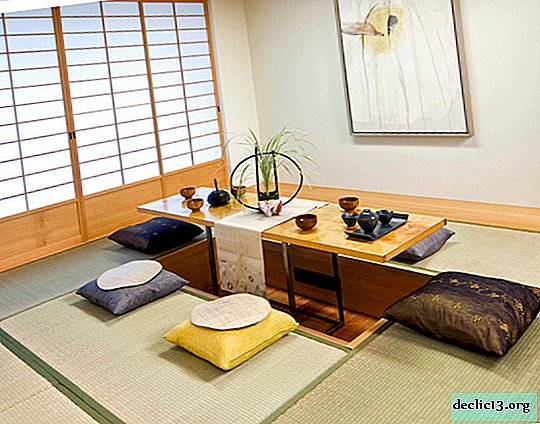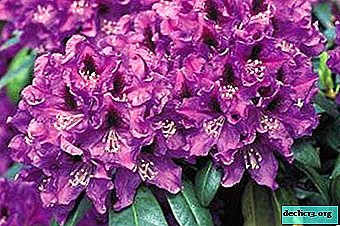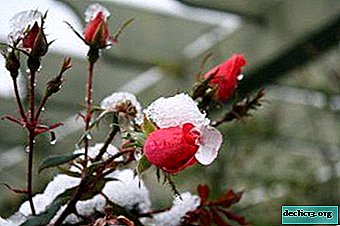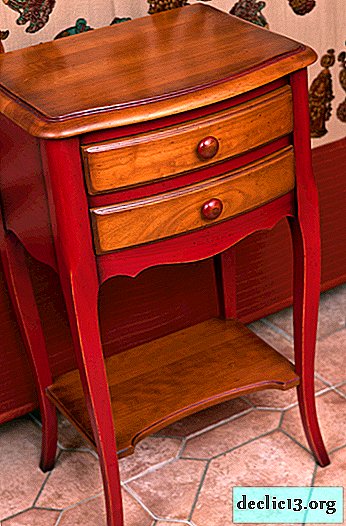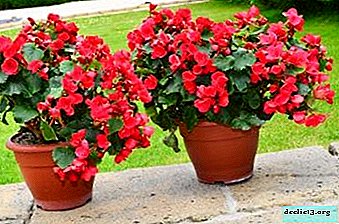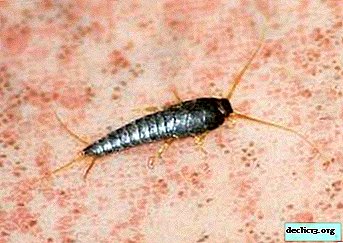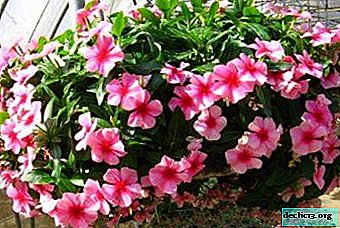Amazing euphorbia - home care instructions, plant photo
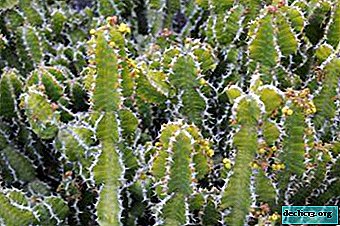 The genus euphorbia in nature encompasses many plants for every taste: from small miniature, almost dwarf individuals, to tall trees. In appearance, some euphorbia look like cacti. For example, in the milkweed of Ceresiform, single spikes are located on the ribbed shoots, and in milkweed trihedral on the fleshy trunk, short hooks and thorns. Despite the external similarity, euphorbiae are not cacti, but are included in the group of succulents.
The genus euphorbia in nature encompasses many plants for every taste: from small miniature, almost dwarf individuals, to tall trees. In appearance, some euphorbia look like cacti. For example, in the milkweed of Ceresiform, single spikes are located on the ribbed shoots, and in milkweed trihedral on the fleshy trunk, short hooks and thorns. Despite the external similarity, euphorbiae are not cacti, but are included in the group of succulents.
Features of flower care
Let's try to describe common standards for the care of plants that vary in appearance and in distinctive properties. Coming from the tropics and subtropics of the driest and hottest parts of the world, succulents have common features, and when caring for them at home, you must adhere to certain rules.
Lighting
Reference. In the natural environment, euphorbia grows in the shade under the foliage that has covered it. Hence their love for a slightly diffused but bright light.Placing on the southern windowsills, the plant needs to be slightly covered from the scorching sun. Otherwise, the leaves, subject to solar radiation, may darken and become covered with protective pigments of a dark brown color. But the flower does not like complete shading - it stretches, becomes thinner.
In the summer, it is advisable to make flower pots in the sun, but remove from direct burning rays.
How to water?
Like many succulents, Euphorbia is not afraid of a small dry soil or air. When growing at home, the following watering rules should be followed:
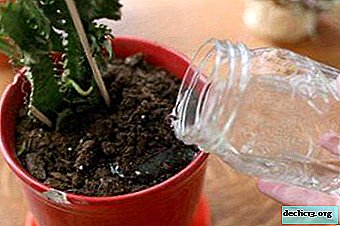 During the growing season, the plant is watered at least twice a week.
During the growing season, the plant is watered at least twice a week.- In the summer, during the very hot months, regularly and every week.
- In winter, watering is reduced once a month.
- You should periodically inspect the soil, if the lump of earth crumbles, then the plant requires watering.
- Between watering, the potted soil should dry well, but not be overdried.
- Water for irrigation is taken warm, settled, soft.
- It is not necessary to spray euphorbia. But do not keep near the battery where the air is dry.
Errors during watering:
- if the water is excessively cold, the stem at the bottom of the plant becomes dark in color and becomes covered with a rough crust;
- if the plant is flooded, the earth is constantly wet, the roots of milkweed can rot.
Where does euphorbia store moisture?
On a note. Euphorbia - stem succulents (succus - juice) have a distinctive feature: they adapted to collect and store moisture for a long time.This genus was formed, surviving in arid areas, hence the structure of their stems: the core and bark contain water-retaining tissues. The organs in which moisture is stored are thick ribbed stems of succulents.
In nature, in the rainy season, folds on the bark are straightened so that the plant does not suffer, having absorbed excess fluid. Moisture sources can be dew, rain, groundwater. Only in case of acute need, euphorbia, thanks to the cellular juice, uses the accumulated water.
Temperature
Some species of Euphorbia will require a special thermal regime, which can be provided to them in greenhouses, greenhouses with the help of special heated constructions.
At home:
- in summer, euphorbiaceae develop successfully at temperatures from + 22 ° C to + 26 ° C;
- in winter, the plant has a dormant period, which means that the air can be warmed up not lower than + 13 ° С.
Soil composition
 For euphorbia, the soil should not be dense, with high acidity. Suitable light, loose and permeable soil. The substrate can be prepared in one of the following ways:
For euphorbia, the soil should not be dense, with high acidity. Suitable light, loose and permeable soil. The substrate can be prepared in one of the following ways:
- make up the soil from leafy soil, humus and sand (2: 3: 2);
- add coarse perlite to three parts of sphagnum moss;
- mix equal parts of the ingredients: peat, turf land, leaf land, sand;
- purchase a nutrient substrate for succulents in a flower shop.
Pot
Choosing a pot for euphorbia, you need to take into account the characteristics of the cultivated species.
General recommendations:
- Select the capacity, given the active vegetation of the plant: the roots grow quickly.
- It is better to take a clay pot: quick drying of the compost prevents root decay.
- Select the depth of the container, taking into account 3 cm of the drainage layer.
- The next pot at the next transplant should be slightly larger than the previous one.
Fertilizers
Euphorbia responds well to timely feeding. With a deficiency of the nutrient medium, the leaves will begin to turn yellow and fade. Feeding should be as follows:
- During the growing season, euphorbia should be fed with complex mineral fertilizers for succulents.
- Varieties without flowering can be fed with fertilizers for cacti.
- Flowering varieties need potash supplements.
- Feeding is carried out from spring to autumn, but does not need to be fertilized during the dormant period.
- Frequency of feeding - twice a month.
Pruning
After euphorbia fades, in the summer, pruning wilted buds is carried out. To maintain the shape of the bush, excessively long shoots are removed. If in early spring a part of young shoots is cut off from milkweed, then the plant will not bloom in summer, but will form a lush bush next year.
When pruning euphorbia, avoid contact with the plant sap.known as latex. Juice contains the dangerous substance euphorbin, which can cause severe skin irritation and inflammation of the mucous membranes.
Transfer
 Euphorbia requires regular transplantation in the first years of life in order to grow and branch, to form young shoots. Young specimens need to be moved to more spacious pots annually, adult plants are transplanted when the volume of the pot is filled with roots - no more than once every three years.
Euphorbia requires regular transplantation in the first years of life in order to grow and branch, to form young shoots. Young specimens need to be moved to more spacious pots annually, adult plants are transplanted when the volume of the pot is filled with roots - no more than once every three years.
Euphorbia is transplanted in early summer, during the growth period, in which case the plant will have time to adapt to new conditions.
The transplant process includes the following procedure:
- moisten the soil so that the plant is easier to extract from the old pot;
- gently pull the euphorbia from the container, using a knife to separate the soil from the walls;
- remove damaged roots;
- gently shake off excess earth;
- by transfer method, transfer the plant to a new pot, with drainage at the bottom and a thin layer of fresh soil;
- pour in the prepared substrate;
- compact the surface of the soil with your hands;
- pour transplanted plant with warm water with bait.
How to care immediately after purchase?
Immediately after the purchase, you should transplant euphorbia into a more suitable pot and soil. From the store, the flower arrives in a container suitable for transportation, but not for life.
If the container is suitable for growing, then the substrate in it is special, with the addition of growth stimulants.
After replanting in an optimal container with a nutrient mixture, care should be taken to flower the following way: transfer to a constant place, provide bright diffused lighting, moisten the soil, maintain the optimal temperature regime of + 21 ° С ... + 24 ° С.
Features of the content in the open ground
They grow euphorbia more often in an apartment, but many of them feel great in open ground, on flower beds. If in the house the euphorbia is a perennial plant, then in the garden it often grows as an annual.
Sow the seeds immediately into the ground, or plant the finished seedlings. The unpretentiousness of the plant is also manifested in the open ground. In the garden, euphorbia prefers sunny places and loose soil, but it will grow in a cooler place and on heavier soil - it depends on the type of milkweed.
Note! Euphorbia does not like frequent transplants; young shoots are growing slowly.Garden plant propagated by dividing bushes, after which they are immediately planted in a permanent place.
Wintering
In winter, euphorbia needs a rest period. Euphorbiaceae tolerate winter well, but plants need to create optimal conditions for this.
How to prepare a plant?
 Preparation for wintering includes:
Preparation for wintering includes:
- In mid-October, euphorbia should artificially reduce lighting: give an additional dark time from 6 pm to 8 am.
In the evening, the flower can be transferred to an unlit place or covered with black material.
- In the afternoon, keep the previous conditions.
- Restrictions maintain one and a half months.
How to care in winter?
Milkweed care in winter boils down to the following:
- Water euphorbia only if the soil dries up to 3 cm.
- Keep in a cool place. Winter temperature can be in the range + 10 ° С ... + 13 ° С.
In a hot room, but in low light, the plant will greatly stretch and weaken. If you do not create the right conditions for wintering, then this may affect further slow growth.
Flowering and dormancy
Euphorbia is famous for the widest range of species diversity, and this is also expressed in the shape and color of the flowers. Most often they are small with a yellow or white tint. The flowering period, depending on the species, falls on the period from March to October.
Sometimes the plant stops blooming. Usually this is due to growing conditions: too dry in the room, irregularity in watering mode. It should be remembered that euphorbia needs a period of rest. The absence of this phase in the life of the plant can affect flowering. Rest of euphorbiae is expressed in the fact that they reduce watering, transfer the flower pot to a dimly lit place for up to two months. Air temperature no more than + 18 ° С.
Important! In order for euphorbia to bloom in the summer, do not cut young shoots during the growing season.Photo
In the photo below you can see what a plant called euphorbia looks like.
Euphorbia alba:

Euphorbia Mile:

Euphorbia fat:

Euphorbia triangular:

Euphorbia is strong:

Pests and diseases
Reference. Euphorbia is a pest resistant species. Euphorbiaceae can be attacked: aphids, whiteflies, spider mites, mealybugs.With the defeat of euphorbia:
- aphids - the leaves curl, fall off, discolor;
- whitefly - light spots and larvae appear on the leaves, the plant dries;
- mealybug - you can find white fluffy lumps on the stem, which will not bring much harm to the flower, but can spread to other indoor plants;
- red spider mite - damage the plant tissue, form small dark dots that can be seen on the entire surface of the flower.
A plant can get sick with fungal and viral diseases: black root rot, alternariosis, bacteriosis and others. Diseases affect euphorbia in case of prolonged contact with cold moist soil, or in extreme heat, fungi can be in the soil.
It should be ensured that the plant is not exposed to mechanical damage., did not coexist with other infected indoor flowers. Sick euphorbium should be treated with special agents against each type of pest or type of infection. Heavily affected and dead plant sections (stems, roots) are best removed. You can read here why milk leaves turn yellow and fall off, as well as what diseases and pests can be dangerous for this plant, you can read here.
Applying the acquired knowledge to care for euphorbia, it is not burdensome to grow this beautiful flower at home. At any time of the year, a pot with a decorative flower will decorate an office or apartment with its lively and vivid appearance.

 During the growing season, the plant is watered at least twice a week.
During the growing season, the plant is watered at least twice a week.